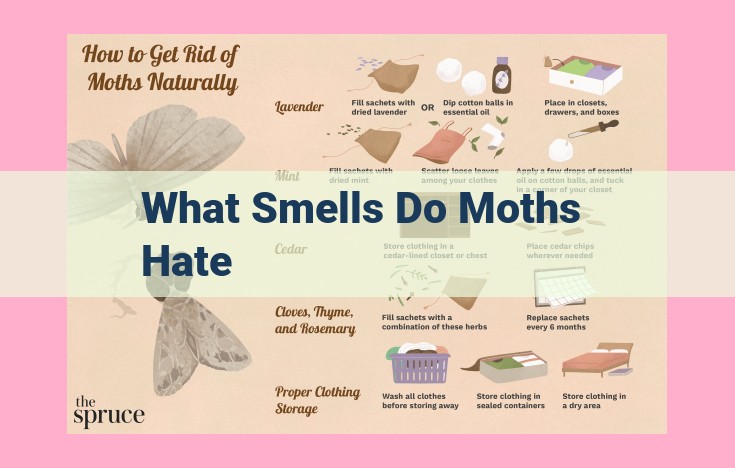Mastering Moth Control: Natural Scents, Chemical Repellents, And Physical Barriers

Moths are highly sensitive to specific scents, making it possible to deter them using both natural and chemical repellents. Essential oils like cedarwood, lavender, and eucalyptus emit strong aromas that repel moths, while mothball alternatives such as vinegar, tobacco, and pest strips release chemical odors that effectively keep them away. Additionally, physical barriers like cedar chests and lavender sachets, combined with proper storage practices, can prevent moth infestations by blocking their entry and access to fabrics.
Essential Oils and Natural Repellents: The Scent of Defense
In the battle against fabric-destroying moths, natural scents emerge as a formidable defense. Essential oils, with their potent aromas, have the power to deter these unwanted pests, safeguarding your precious garments.
Discover the remarkable efficacy of cedarwood, lavender, and eucalyptus. These aromatic powerhouses emit scents that are highly unappealing to moths, effectively repelling them from your home. By using diffusers or creating fragrant sachets, you can distribute these scents throughout your space, creating a protective shield around your fabrics. Even infusing wood with these oils can ward off moths and add a touch of freshness to your decor.
Chemical Repellents: Mothball Alternatives
Protecting your cherished fabrics from the destructive clutches of moths is a battle as old as time. While mothballs have long been a staple in this battle, their pungent odor and potential hazards have raised concerns. Fear not, for there are less toxic chemical repellents that can effectively guard your precious textiles.
Vinegar: A Time-Tested Remedy
Harnessing the pungent properties of vinegar, this centuries-old solution proves effective in repelling moths. Soak cotton balls in white vinegar and strategically place them around areas where moths may lurk. The acidic aroma acts as a natural deterrent, creating an unwelcome environment for these pesky critters.
Tobacco: A Moth’s Kryptonite
Tobacco’s strong scent is particularly unpalatable to moths. Scatter loose tobacco leaves in drawers and closets, or place tobacco-filled pouches among your fabrics. While effective, note that tobacco products may leave a lingering odor and can be an irritant for some individuals.
Moth-Specific Pest Strips: Targeted Defense
Commercially available moth-specific pest strips provide a targeted approach to moth control. These strips contain pheromones, which attract male moths, disrupting their mating cycle. However, their effectiveness may vary depending on the species of moth, and some may lose potency over time.
Pros and Cons of Chemical Repellents
Benefits:
- Relatively inexpensive and easily accessible
- Effective in repelling moths when used correctly
- Some are environmentally friendly (e.g., vinegar)
Drawbacks:
- Can have a strong or unpleasant odor (e.g., vinegar, tobacco)
- Potential for low efficacy against certain moth species
- Some may require frequent replacement
Remember, chemical repellents should be used in conjunction with physical barriers and prevention techniques to provide comprehensive protection against moths. Keep your fabrics fresh and free from moth damage with these effective and less toxic alternatives to mothballs.
Physical Barriers and Prevention Techniques: Keeping the Moth Menace Away
When it comes to protecting precious fabrics from the dreaded moth invasion, prevention is paramount. Enter the realm of physical barriers and prevention techniques. These time-honored methods provide a formidable defense against these fabric-loving pests.
Outsmarting Moths with Physical Barriers
-
Cedar Chests: The aromatic scent of cedarwood has long been a trusted moth repellent. These handsome chests offer both style and functionality, providing a safe haven for your cherished belongings.
-
Lavender Sachets: The delicate fragrance of lavender permeates the air, creating an irresistible olfactory shield against moths. Tuck these fragrant pouches amidst your clothing, linen, or anywhere moths might lurk.
-
Moth-Proof Bags and Garment Covers: These protective barriers physically separate textiles from moths and their eggs. Choose airtight and breathable materials to ensure maximum protection.
Prevention: A Moth’s Worst Nightmare
Prevention is as crucial as defense when it comes to moth control. Embracing these techniques minimizes their chances of infiltrating your home:
-
Dry Cleaning: Give your garments a professional makeover by opting for dry cleaning. This process eliminates moth eggs and larvae that may be hiding in the fabric’s fibers.
-
Vacuuming Regularly: A thorough vacuuming regimen removes moth eggs, larvae, and adult moths from carpets, furniture, and other fabric surfaces. Pay special attention to corners, crevices, and areas where moths tend to congregate.
-
Regular Inspections: Inspect your clothes, linen, and other vulnerable textiles on a regular basis. Look for any signs of moth activity, such as holes, frass (moth droppings), or webbing. Early detection is key to preventing a full-blown infestation.
By implementing these physical barriers and prevention techniques, you can create an unwelcoming environment for moths. Protect your fabrics, safeguard your memories, and enjoy the peace of mind that comes with knowing your textiles are safe from these fabric-destroying pests.